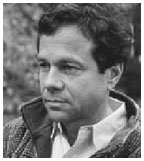Have an opinion about this issue of PAW? Please take a minute to click here and fill out our online questionnaire. It’s an easy way to let the editors know what you like and dislike, and how you think PAW might do better. (All responses will be kept anonymous.) |
Alan Lightman ’70 (Jean Lightman) |
April 20, 2005: From the Editor
“Ever since I was a young boy, my passions have been divided between science and art. I was fortunate to make a life in both, as a physicist and a novelist, and even to find creative sympathies between the two, but I have had to live with a constant tension in myself and a continual rumbling in my gut.”
So writes Alan Lightman ’70 at the beginning of his new collection of essays, A Sense of the Mysterious. On page 26, we present one of those essays, “Portrait of the Writer as a Young Scientist,” in which Lightman, now a humanities professor at MIT, describes some of the things he misses from his work in theoretical physics, including the certainty of “an answer that had never been known before.”
His two passions, while quite different, also have more in common than we might at first appreciate. In one essay, Lightman writes of the intensity of the creative moment he experienced when he began to resolve a sticky research problem. It was a sensation he later experienced as a novelist.
There are many places at Princeton where science and the arts come together, and many people who have found that the qualities of mind of a scientist also can make for good art, and vice versa. For a contest, photographer Andrew Moore ’79, a Princeton lecturer, is soliciting beautiful images from scientific research or technical innovation, such as a microscopic view of a cell or a computer simulation of a fluid flow. A new lecture series, billed as “/@rts,” aims to explore the interrelations of new media, technology, and the arts and humanities; among the speakers are visual artists, composers, and computer scientists. In its strategic planning sessions, faculty members in the School of Engineering and Applied Science debated such questions as: What opportunities for excellence and greater collaboration exist at the intersection of engineering and music, and engineering and the visual arts?
Philip Holmes, a professor of mechanical and aerospace engineering and applied and computational mathematics, is also a published poet who believes that both poetry and science are ways of approaching and understanding the world. (To read several of his poems, click here.)
“I write and do mathematics, science, and engineering all for the same basic reasons: to come to terms with things that I don’t understand; to help me formulate questions and (sometimes) answer them,” he wrote in an e-mail. “There’s great elegance and beauty in mathematics, as in poetry. Poems, like mathematical models, focus, condense, and sharpen pieces of the world, and allow us to better appreciate them.”
PAW notes the death on March 17 of George F. Kennan ’25, diplomat
and author of the “Long Telegram,” which established the containment
policy that guided the United States in its dealings with the Soviet Union
during the Cold War. He was 101. Fletcher M. Burton *88, the American
consul general in Leipzig, Germany, has written a critique of the Long
Telegram; we
offer it online, click here to read. ![]()
![]()
Marilyn H. Marks *86
mmarks@princeton.edu


